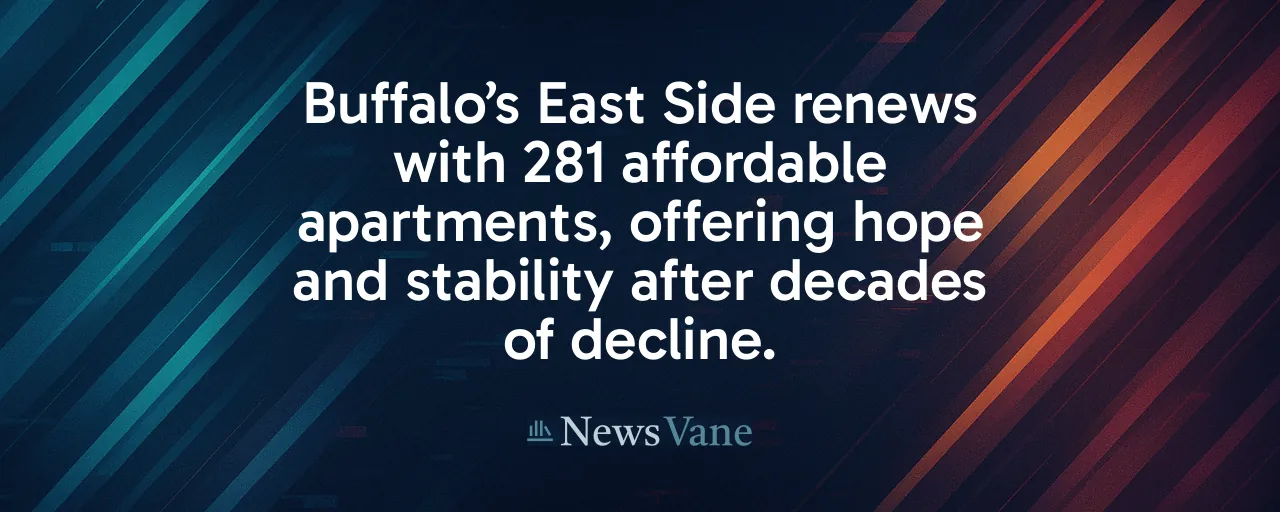A Fresh Start for Buffalo's East Side
Buffalo's East Side has a new reason to look up. The Ellicott Town Center, a 281-unit affordable housing complex near downtown, reopened in June after a $71 million overhaul. Once a symbol of the city's economic decline, the revitalized buildings now offer modern apartments and a brighter future for families and seniors.
Beacon Communities and First Shiloh Development LLC, tied to First Shiloh Baptist Church, led the effort. Their work builds on New York's $50 million investment in the East Side, aiming to stabilize a neighborhood that's faced decades of hardship. This project goes beyond repairs, seeking to restore hope for residents who've long called this community home.
Across the U.S., affordable housing is increasingly out of reach. Buffalo feels that pinch, with rising rents and home prices squeezing low-income households. Developments like Ellicott Town Center provide critical relief, ensuring people earning below 90 percent of the area's median income can live securely.
Inside the Transformation
The Ellicott Town Center, first built in 1958 as Ellicott Mall, includes four high-rise towers and 24 townhomes reserved for residents over 55. The rehab upgraded every aspect of the complex. New windows, roofs, and sidewalks enhance the exterior, while modernized kitchens and bathrooms improve daily life. Energy-saving features, like better lighting, promise a 20 percent reduction in utility costs.
A mix of funding made it possible: $31 million from federal Low-Income Housing Tax Credits, $36 million in tax-exempt bonds, and $23 million in state subsidies. A $300,000 grant from the Clean Energy Initiative, a state housing and energy collaboration, supported green upgrades. These changes align with New York's goal of sustainable, equitable housing.
Construction unfolded in phases, allowing residents to stay on-site by moving to vacant units temporarily. This careful approach reduced stress for low-income families, who often face upheaval during large-scale renovations.
A National Housing Challenge
Buffalo's housing struggles mirror a nationwide crisis. Over 100 million U.S. households can't afford a median-priced home, and seven million affordable rental units are missing. In 2024, new affordable housing projects fell nearly 29 percent, deepening the shortage. High mortgage rates and inflation keep homeownership elusive, while renters face relentless cost increases.
Advocates for increased public investment in housing advocate boosting public funds, pointing to tools like rental vouchers and tax credits to expand supply. Proponents of market-driven solutions prioritize relaxing zoning laws to spur private construction or encouraging homeownership for wealth-building. Both perspectives highlight the urgency, though their paths to solutions diverge.
The Ellicott project demonstrates the power of blending public, private, and community resources. By leveraging state and federal funds alongside faith-based leadership, it preserved affordability in a way that neither government nor markets could achieve alone. Still, with millions nationwide needing stable housing, replicating this model on a larger scale remains a steep challenge.
Community at the Core
First Shiloh Baptist Church's role in the project underscores the value of local leadership. Their focus went beyond bricks and mortar, prioritizing the families and seniors who define the East Side. This community-driven approach sets a new standard for urban renewal, learning from past efforts that often sidelined residents.
History shows revitalization can be a double-edged sword. Mid-20th-century projects in cities like New York and Chicago displaced thousands, often harming communities of color. Modern strategies, like community land trusts and inclusive zoning, aim to protect affordability and preserve culture. Buffalo's project reflects these lessons, with local voices guiding the process.
Even so, revitalization carries risks. Without careful planning, new investment can disrupt social bonds or raise living costs. The Ellicott rehab seeks to avoid these pitfalls by keeping housing affordable and rooting the project in the East Side's history and values.
A Path Forward
The Ellicott Town Center rehab fits into New York's ambitious $25 billion plan to create or preserve 100,000 affordable homes statewide, with over 60,000 already completed. In Erie County, 11,000 affordable homes have been financed, including nearly 8,000 in Buffalo. These efforts show what's possible when public, private, and community partners work together.
For residents, the benefits are clear: safer homes, lower bills, and a stronger sense of stability. For the East Side, the project marks a commitment to growth that respects the community's roots. Yet, with housing costs climbing and federal funding debates looming, Buffalo and other cities face ongoing pressure to meet demand.
As Ellicott Town Center welcomes residents back, it stands as proof of collaboration's impact. Housing provides shelter and forms the foundation of dignity and opportunity. For Buffalo's East Side, this project is a milestone, but the broader quest for equitable housing presses on.
